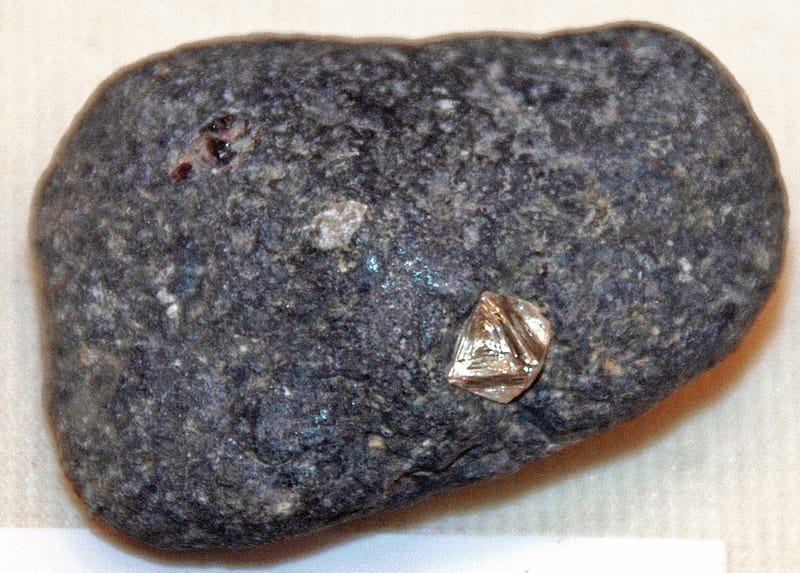
In a fascinating new study, scientists have unraveled the mysterious origins of the diamonds that adorn our jewelry. Contrary to their dazzling appearance, these precious gemstones had a tumultuous journey to the Earth’s surface through violent volcanic eruptions millions of years ago.
A diamond’s journey begins deep within Earth’s mantle, over 100 miles (160 km) deep below the surface, where immense temperatures and pressure force carbon atoms to arrange themselves into a unique crystalline structure. Deep-rooted volcanic pipes or conduits carry these gems, transporting them upward through the Earth’s layers. Ultimately, they scatter on the surface after they are shot up by spectacular, powerful volcanic eruptions.
However, these aren’t pure diamonds. The gemstones are encased in blue-tinged rocks known as kimberlites. This much was known fairly well with a high degree of confidence until now. What was missing was why and how exactly these kimberlites formed and subsequently migrated to the surface after spending millions of years tucked inside the mantle.
The new study led by Dr. Thomas Gernon from the University of Southampton is now bridging this gap in our understanding, showing that the ancient breakup of continents is key to forming these diamonds. The findings shed light on the enigmatic processes responsible for these rare eruptions and provide valuable insight into where diamond-rich deposits are most likely to be found.
It’s raining diamonds
The geologists analyzed historical data on continental plates and kimberlite eruptions to understand how diamonds travel from their birthplace in the Earth’s depths to the surface. The team observed that over the past billion years, most kimberlite eruptions occurred approximately 25 million years after continental plates tore apart.
A closer examination of this link revealed that the initial kimberlite eruptions were closer to the plate edges, with later eruptions occurring progressively toward the middle of the plate. These eruptions were also greatly delayed, ejecting the diamond-rich mineral about 26 million years after the breakup of supercontinents like Pangaea.

Diamond crystal in kimberlite from the mid-Paleozoic of Siberia, Russia. Credit: Wikimedia Commons.
The process begins when continental plates stretch as they start to tear apart. This stretching causes the rock to become thinner and disrupts the normal flow of material in Earth’s mantle — the layer directly beneath the crust. The disruption in the mantle results in the detachment of chunks of rock from the base of the continental plate, which drip like hot wax.
Over hundreds of millions of years, under immense pressure, these rocks undergo a transformation, changing carbon deposits into precious diamonds. As these rock chunks sink into the mantle, they trigger even more disruptive flows, stripping layers of rock tens of miles thick from the bottom of the plate above.
The domino effect of these disruptive flows eventually forges diamond-bearing kimberlite magma. And when enough melt has formed, it rapidly rises and forcefully blasts through the crust, creating powerful eruptions.
Kimberlite eruptions differ from regular volcanic eruptions. Instead of forming typical volcanic cones, they leave behind vertical pipe-like holes in the ground called cratons. Many diamond mines lie directly beneath these unique formations.
The most recent kimberlite eruption occurred approximately 11,000 years ago at Igwisi Hills in Tanzania, while most eruptions took place during the Cretaceous period, around 146 to 66 million years ago.
“We know where, when and why kimberlites are forming and that’s really useful for exploration,” Gernon told The Guardian. “We know the events needed to trigger this domino effect, and by joining the dots, we can target those areas that hold the most promise for diamonds to be there in the first place.”
“These eruptions are quite rare in Earth’s history because they require this perfect storm of conditions and events to generate them,” he added. “The dinosaurs would have been walking around in some of these areas, watching these events, and they would have been quite perplexed. They are extremely rapid events and they probably wouldn’t be expecting them.”
Although the study presents compelling evidence supporting their model, the case is not entirely closed. Some critics believe that while supercontinent breakups play a significant role in kimberlite eruptions, other factors may also be involved. The process of supercontinent breakups involves a complex interplay of various geological processes, making it challenging to pinpoint the exact cause of kimberlite eruptions.
The findings appeared in the journal Nature.






